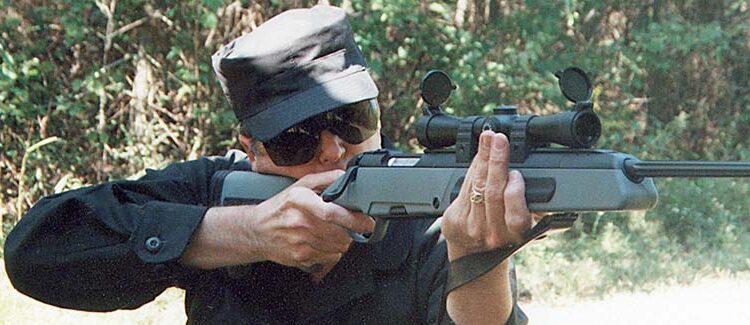By Charles Q. Cutshaw
The recent introduction of Steyr’s Scout Rifle has created a great deal of interest in the world’s firearms community, mostly among firearms aficionados. The fact is, however, that the rifle has definite capabilities for use by military scout-sniper teams and for law enforcement. In this article, SAR evaluates Steyr’s new rifle and its military/law enforcement potential.
The scout rifle concept dates to the Second World War when the German Wehrmacht introduced the Karabiner 98k mit Zielfernrohr 41 (Model 98k Carbine with Model 41 Telescopic Sight -Kar98k-ZF41). The ZF41 telescopic sight was not intended to be a precision sight, but rather a sight for quick shots in combat. Its magnification was only 1.5 power and the rifle-telescope combination was very popular with the German military; nearly 90,000 were produced and plans called for 370,000 more when wartime exigencies caused telescope orders to be canceled. After World War II, the scout rifle idea lay dormant until it was resurrected by one of the firearms fraternity’s legends, Col. Jeff Cooper. Col. Cooper set the requirements for the modern scout rifle which differ somewhat from the WW II original. Before examining the scout rifle concept, however, we must understand the advantages of an intermediate eye relief low powered telescope mounted on a lightweight rifle.

Shooting a rifle well is a true challenge, especially when using open sights. Traditional “V” or “notch” rear sights are especially challenging because the shooter must concentrate on three points at once – the rear sight, the front sight and the target. The aperture or diopter sight ameliorates this problem somewhat, but the challenge of achieving correct sight alignment and sight picture remains. Sight alignment, particularly, is critical when using open sights of any type. Optical sights eliminate the need for obtaining correct sight alignment and picture, but introduce another set of problems all their own. When using optics of any magnification greater than approximately four power, target acquisition is slowed, with the difficulty of target acquisition in direct proportion to the degree of magnification. Probably the best of both worlds are “collimator” or “red dot” sights, such as Aimpoint, which have no magnification whatsoever. Many of these require batteries for power, however, and thus do not fit within the guidelines for a scout rifle because of the propensity of batteries to fail at the worst possible time as a corollary of Murphy’s Third Law. (Anything that can potentially go wrong, will – at the worst possible time!) Low power optics require no external power source, however, and thus are as reliable as such a device can be. From a shooting standpoint, their effect is to decrease the target acquisition time of the shooter while enhancing his accuracy. The method of using such sights is easy to learn and essentially requires only that the shooter keep both eyes open and on the target as he brings the rifle to his shoulder. As he shoulders the rifle and attains his shooting position, the crosshairs of the optic fall almost directly onto the center of the target, essentially where the shooter’s eyes are focused. This system is far superior to open sights in this respect. The sole disadvantage to the use of an intermediate eye relief, low power telescope is the fact that it is more fragile than open, or “iron” sights. Most quality modern optical sights are fairly rugged, however, and unless dropped directly onto a hard surface they can be expected to weather most exigencies. The scout rifle is envisioned as a general purpose rifle, suitable for any use from sport to combat and thus must be of a caliber suitable for killing any living target up to about 1,000 lb, eliminating current military calibers of 5.56x45mm (.223 Remington). The scout rifle will thus be chambered for a “full-power” 7.62mm (.30 caliber) cartridge, which for military use virtually mandates 7.62x51mm (.308 Winchester). Other points with regard to the ideal scout rifle are as follows:
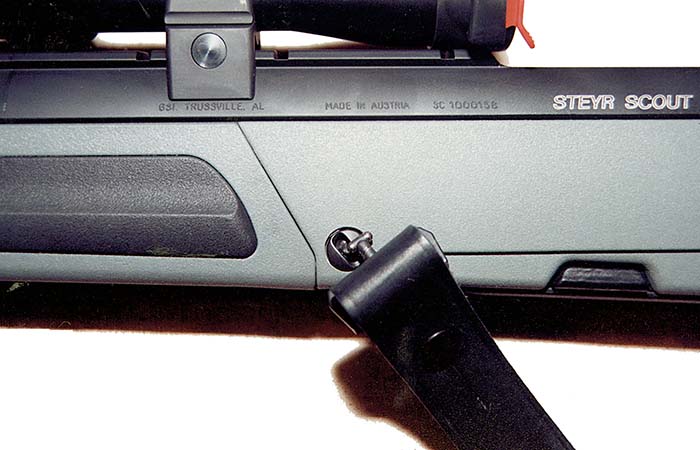
A -The rifle should be a “repeater.” It should permit successive shots to be taken without reloading. The rifle will probably be a bolt action, as semiautomatic rifles tend to fall above the established weight limitation.
B -The rifle should be handy. That is, it should not be excessively heavy or overly long. Length should be no more than one meter (approximately 39 inches) and weight should be no more than about 3.1kg (seven pounds), the weight that most persons in relatively good physical condition can comfortably carry in one hand for an extended period. Rifles beyond these parameters are considered too cumbersome.
C -The buttstock of the scout rifle should not be too long, which renders the rifle slow and unwieldy. An adjustable stock is not mandated in Col. Cooper’s requirements for the scout rifle, but it is clear that an adjustable buttstock would be ideal.
D -The rifle should be “friendly.” Essentially this implies good ergonomics, with a line of sight as low as possible over the bore and the position of the shooting hand when ready to fire no more than three inches below the bore axis. A third component is the relationship of the bore axis to the stock. If the bore axis is above the stock, recoil forces are directed down, increasing felt recoil and making follow-up shots more difficult. Thus, the bore and stock should be as close as possible to straight line alignment.
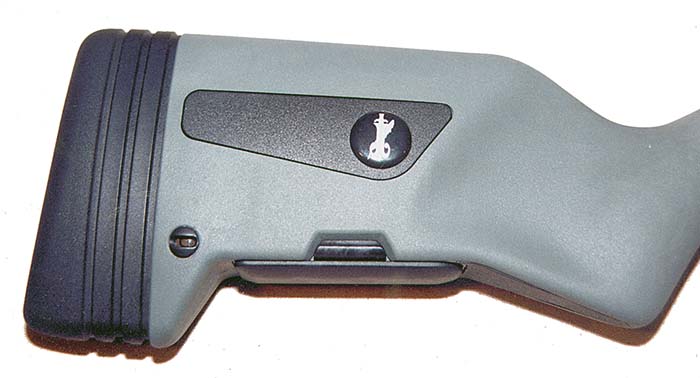
E -The rifle should have a functional sling, preferably a “Ching Sling,” probably the best of its class due to its three-point attachment.
F -The rifle should not be intimidating. This implies that recoil is manageable and muzzle blast not overly loud.
G -The trigger should break like a “glass rod.” That is, there should be no perceived movement in the trigger as the sear is released. This is not to say that there should be no “slack” as is the case with all two-stage triggers. Once the slack is taken up, however, the trigger should release the sear without the shooter feeling any movement whatsoever.
As the military established a requirement to meet a perceived shortcoming, we have explored the perceived shortcoming and what qualities a scout rifle should have to fill it. This begs the question of how well Steyr’s new rifle meets the need and Col. Cooper’s vision. To preclude suspense, and so the reader can avoid slipping to the end of this article, we will go straight to the heart of the matter. This writer can think of only one word to describe the Steyr Scout Rifle – excellent, with one reservation. Now, let’s see what attributes justify such high praise from one who was a true skeptic about the entire scout rifle concept until he actually shot Steyr’s latest product.
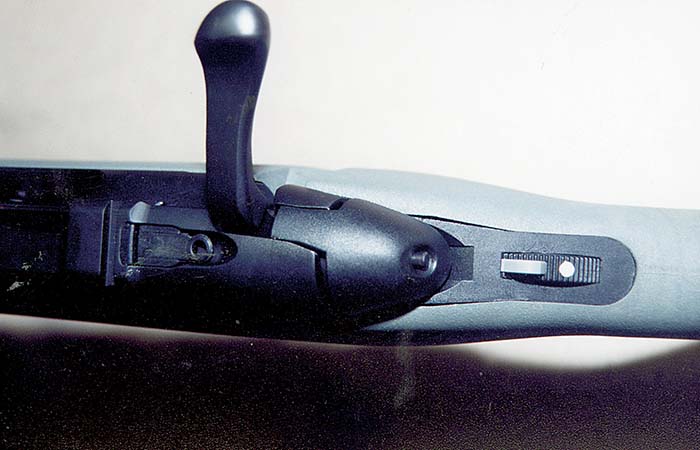
First, the Steyr meets or surpasses all of Colonel Cooper’s requirements. It is light at only 3.1kg (7 lb) with telescope. It is handy, with its 748mm (19 in) barrel and overall length of just over one meter (39.57 in). The trigger is two-stage military style and once the slack is taken up there is no “creep” whatsoever and it truly breaks like the proverbial “glass rod” at 1.7kg (3.75 lb) on SAR’s test rifle. An English saddle leather “Ching Sling” accompanies each Scout and the rifle is set up with ambidextrous quick mounting points, so the sling can be quickly mounted and dismounted as desired. And finally, the recoil and blast of the rifle in 7.62x51mm (.308 Winchester) are not at all intimidating, at least not to this writer. This is attributable to the rifle’s design as much as to the cartridge, as we will presently see.
Other attributes of the Steyr that surpass the original concept are the detachable box magazine that has a double detent which allows it to be positioned so that single cartridges can be fed while maintaining a full magazine of either five or optional ten rounds. A spare magazine is carried in a buttstock well for quick reloading. Although the 2.5x Leupold telescope is mounted forward of the receiver ring, there is provision for accommodating a conventional telescopic sight using standard NATO mounting. Backup open sights are folded down out of the way until they are required. The cold hammer forged barrel is fluted for extra stiffness. The non-slip Zytel buttstock features spacers for adjustment of the length of pull to suit shooters of any conceivable size and has an integral fold away bipod, plus an accessory mounting rail beneath the forearm. Fit and finish of all parts is excellent, although it must be noted that this rifle is made for hard use, not to decorate the gun case of an admiring collector.
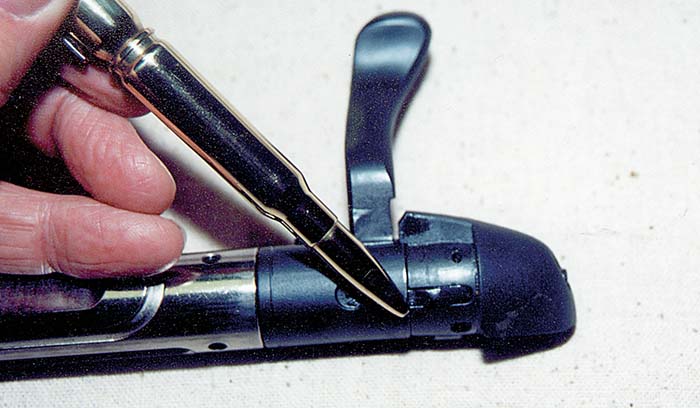
Recoil is managed in several ingenious ways. The 7.62mm NATO cartridge does not recoil excessively and can be handled by most shooters, but many smaller framed shooters might find the recoil of any full-power cartridge excessive, so the Steyr Scout incorporates a virtually “straight line” design which aligns the barrel and stock in such a way that recoil forces are directed straight back to the shooter’s shoulder. This not only reduces felt recoil, but facilitates quick recovery for successive shots. The trigger guard is “faired” at the rear to ease the forces on the shooter’s middle finger and the butt incorporates a recoil pad. Atop the receiver, controls such as bolt handle and ambidextrous safety are placed so that they will not impact the thumb of the shooter in recoil, regardless of how the rifle is held. The rifle comes ready to shoot upon delivery. It is pre-zeroed at the factory and although this writer was very skeptical, we found the Scout to shoot nearly at point of aim at 100 meters using Black Hills or Remington 168 grain and Cor-Bon 125 grain match ammunition. Bringing cross hairs of the Leupold telescope to the exact center of the target required only one click adjustment in windage and elevation. The shot groups were within minute of angle (MOA) at 100 yards using all three brands of ammunition in the (unfortunately) limited firing time that we had available in preparation of this evaluation.
Our sole complaint about the Steyr Scout is that our test rifle initially produced several misfires with each brand of ammunition we fired in it. We queried Steyr’s US. representative regarding these unexpected malfunctions and found that it was the fault of the factory striker spring setting. The striker tension was lightened because some members of the American firearms press complained about excessive resistance when lifting the bolt handle of pre-production models of the rifle. Rectifying the problem was very simple and involved no more than removing the striker assembly, which is covered in the operator’s manual, and then adjusting the striker spring tension. After tightening the striker spring, we found no discernable difference in effort required to lift the rifle’s bolt handle and the misfire problem disappeared. Those who encounter misfire problems should contact their Steyr representative to obtain exact procedures for making the adjustment. This was our sole complaint about the rifle’s performance while we had it for evaluation. It would also be welcome for a left-hand version to be made to accommodate the approximately 20 per cent of the population who are forced to operate an otherwise superb rifle essentially backwards.
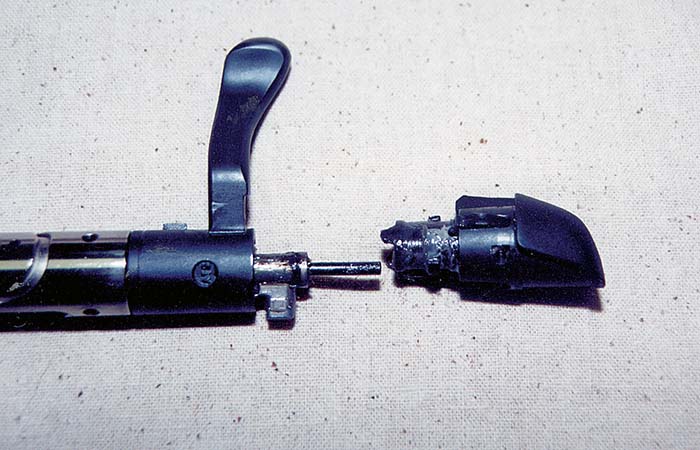
What is the military or law enforcement usefulness of the bolt-action Steyr Scout in this day of fully automatic military firearms? Colonel Cooper claims that one of the primary roles of this rifle is its use by a military scout, although the traditional lone military scout has been replaced by reconnaissance teams, long range patrols, or scout-sniper teams, however it should be noted that some snipers occasionally operated alone during the Vietnam Conflict. Lone snipers would not, however, arm themselves with a scout rifle, but with a purpose-built sniper rifle. The long range patrol or reconnaissance team will have a variety of fully automatic weapons available should it encounter enemy forces of any size and be forced to fight. For such missions, the Scout Rifle is clearly not suitable. It is for the spotter member of a scout-sniper team that Steyr’s Scout Rifle is suited. It is the same caliber as most standard military sniping rifles and has the requisite accuracy to serve as a scout-sniper team’s “backup” rifle. Two man scout-sniper teams move by stealth and avoid firefights at all costs. Even if they were armed with fully automatic weapons, a two man scout-sniper team caught in enemy territory would be quickly overwhelmed. Indeed, current military thinking is for the spotter member of the scout-sniper team to be armed with a semiautomatic 7.62x51mm rifle, sometimes termed a “Designated Marksman Rifle” (DMR) while the sniper is armed with a heavy precision built bolt-action rifle. The role of the spotter is to back up the sniper and provide covering fire if necessary using a rifle of somewhat less accuracy and range than the sniper’s high – precision rifle, but capable of delivering a higher rate of fire. The Steyr Scout with optional 10 round magazine could fill that role and would be as reliable as any semiautomatic rifle of equivalent accuracy. Indeed, some military forces have already purchased the Steyr Scout rifle, although they have not disclosed the purposes for which the rifles were purchased.

For law enforcement, the Steyr Scout is a very viable option as a patrol carbine, although we would recommend either frangible or limited penetration ammunition if it is used in this role due to the possibility of overpenetration and ricochets in an urban environment. Typical police encounters are at under 150 meters and at this range 120 grain frangible bullets would be more than adequate for use against any perpetrators, even those wearing body armor. At the same time, frangible ammunition such as that manufactured by Longbow does not overpenetrate or ricochet. Limited penetration ammunition is also an option for urban use in a 7.62mm NATO rifle such as Steyr’s Scout. Limited penetration 168 grain match grade 7.62mm NATO ammunition such as that manufactured by Black Hills will typically penetrate body armor and then break up in the target without exiting. In fact, such ammunition will not overpenetrate a target without body armor. In addition, the attributes of the Scout Rifle’s optical sighting system that simplifies target acquisition and sighting while enhancing accuracy should be a major attraction to law enforcement officers whose opportunities for regular shooting practice are almost nonexistent.
We can sum up, then, by stating that the Steyr Scout Rifle we tested was a very pleasant surprise, save for the easily corrected misfires. It is light, accurate and appears to be sufficiently robust for consideration as a scout-sniper backup rifle and for use in law enforcement. Military customers will probably wish to add some modifications, such as camouflage buttstock and perhaps a flash suppressor, but Steyr’s little Scout Rifle is excellent as it is. Although we were initially skeptical about the entire idea of the scout rifle, the Steyr product convinced us of the concept’s efficacy. We believe that the Steyr Scout Rifle deserves consideration as a candidate for the spotter member of any military scout-sniper organization and by law enforcement as a patrol carbine in combination with the appropriate ammunition.
| This article first appeared in Small Arms Review V2N4 (January 1999) |



